Yesterday I tried to detect DSLWP-B using my 7 element Arrow satellite yagi. The test schedule for DSLWP-B was as follows: active between 21:00 and 23:00 UTC on 2018-06-22. GMSK telemetry transmitted both on 435.4MHz and 436.4MHz. JT4G only on 435.4MHz every 10 minutes starting at 21:10. The idea was to record the tests with my equipment and the run my JT4G detector, which should be able to detect very weak signals. Today I have processed the recorded data and I have obtained a clear detection of one of the JT4G transmissions (albeit with a small SNR margin). This shows that it is possible to detect DSLWP-B with very modest equipment.
The antenna used has been the 7 element UHF section of the Arrow satellite yagi antenna. It was held on a camera tripod in the horizontal polarization and aimed manually and visually at the Moon during the recording session, which spanned from 21:03:16 to 22:33:25 UTC. The receiver was a FUNcube Dongle Pro+ connected to the antenna directly through one meter of RG-58 coaxial cable.
The antenna temperature was between 500K and 1000K. This was measured by observing a 2 or 3dB raise in the noise floor when the antenna was connected, in comparison with a 50 Ohm load, and by assuming a noise figure of 5dB for the FUNcube Dongle Pro+. This makes a total system temperature of 1500 to 2000K. The antenna has an approximate gain of 11dBi, so total G/T was around -20dB/K. This calculation is just a rough approximation, but it should give you an idea of the limited capabilities of my system when comparing it to other stations’ results.
The recording location was just outside my home, in a urban area with moderate noise in the 70cm band. In a quite location with a good LNA, a system temperature of 150K could be achievable. With the same antenna, this results in a G/T of -10dB/K, so the SNR would improve 10dB in comparison to my situation. Thus, not only the antenna is important when trying to receive these weak signals. The noise level can also play a major role. Therefore, it is much more useful to use G/T rather than antenna gain alone to compare different stations.
Linrad was used to record a RAW file with the 16bit samples from the FUNcube Dongle Pro+. The centre frequency was set to 435.448MHz (actually I intended to set it to 435.450MHz, but for some reason Linrad used 435.448MHz). The LNA and mixer gain of the dongle were enabled and a baseband gain of 0dB was used. The RAW recording was processed in GNU Radio to obtain an IQ WAV file at 11025sps centred at 435.400MHz (which can be downloaded here). This WAV file was then processed with my dlswp_jt4.py script.
The results are shown in the figures below.
In all the recording, we only see a significant correlation peak. It is located at 2264.34s since the start of the recording and at frequency of 17.5Hz. The time corresponds to 21:41:00.34. Richard Cresswell and other people on Twitter have reported that the transmissions happened at 21:11 and then every 10 minutes. Therefore, the time for the correlation peak supports that this is a valid detection and not a product of random noise or interference.
In the screenshot linked above, we see that Richard Cresswell, in Suffolk, UK, received the 21:41 beacon at a frequency of 39Hz above 435.400MHz. Since the Doppler seen by Richard and myself is quite similar, the difference of around 20Hz in the frequencies detected by the two of us should be due to the local oscillators of our receivers. A difference of 20Hz works out to about 50ppb in 435MHz, in accordance with typical tolerances of good oscillators. Thus, my detection frequency is consistent with the reception made by Richard.
It is interesting to note that the Doppler as seen from my station at 21:41 UTC should be -737Hz. Taking into account the fact that JT4G is transmitted 1kHz above 435.400MHz, we would expect a frequency of 263Hz above 435.400MHz. Thus, it seems that the transmitter of DSLWP-B was around 210Hz low in frequency. This is consistent with the frequency offset of -200Hz observed in the first VLBI experiment.
The reported SNR of -31.9dB in 2500Hz should be taken with a grain of salt. At such a low SNR this is just a coarse approximation. However, this is for sure a really low SNR. My detection algorithm was designed to detect reliably down to around -25dB, so I deem that this detection has been a matter of luck. If the correlation search is restricted only to feasible times (21:11, 21:21, etc.) and frequencies, then additional transmissions can be detected in my recording at an even lower SNR (for instance, the transmission at 22:21).
The distance between DSLWP-B and my station was around 395807km at the time of the reception of the beacon. This is by far the furthest radio transmission I have received to date (my previous “record” was geostationary satellites).
The path loss for this distance at 435.4MHz is -197.2dB. Since a -32dB SNR in 2500Hz gives a C/N0 of 2dB, taking only free space path loss into account, and using the G/T of -20dB/K estimated above, we estimate an EIRP of 21dBm at DSLWP-B. This doesn’t take into account polarization losses (which should be 3dB, since DSLWP-B transmits circular polarization) and other losses. Factoring in the 3dB of polarization losses and assuming a transmit power of 33dBm, as given here, we get a transmit gain of -9dBic. This is quite in agreement with the gain of -6dBic used in that link budget. Therefore, my SNR and noise measurements seem to match quite well the theory.
In conclusion, this experiment shows that using correlation algorithms such as my JT4G detector, signals on the order of -30dB SNR in 2500Hz can be detected sometimes. This enables very modest stations in noisy urban areas to detect DSLWP-B.
Update 2018-06-24: I have taken some pictures of the antenna and tripod used in the recording. They have been located and oriented in the same manner I did on the night of June 22.
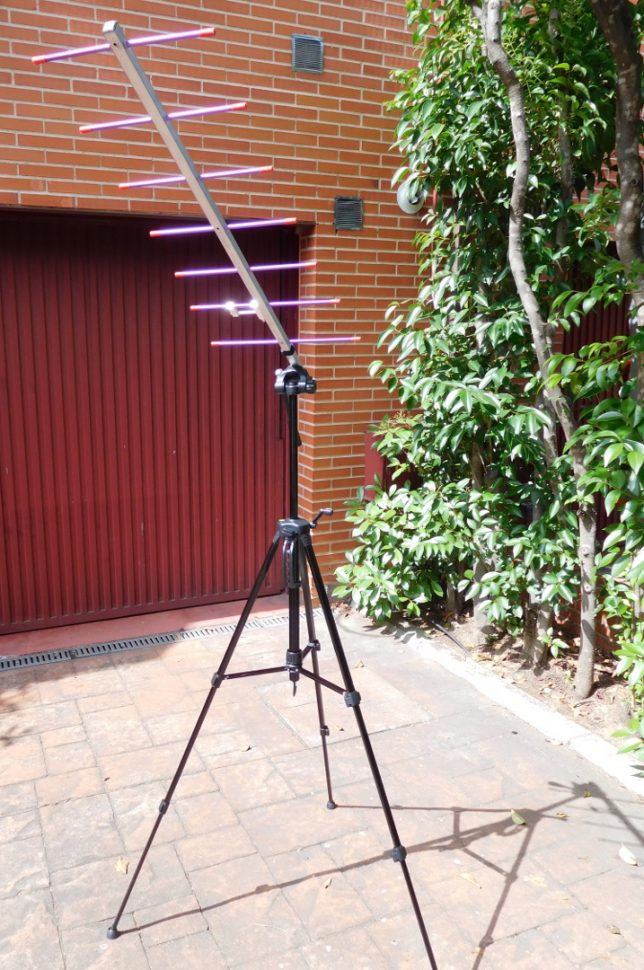
In case the picture below doesn’t make it clear, the view from the antenna to the Moon not obstructed by the trees.
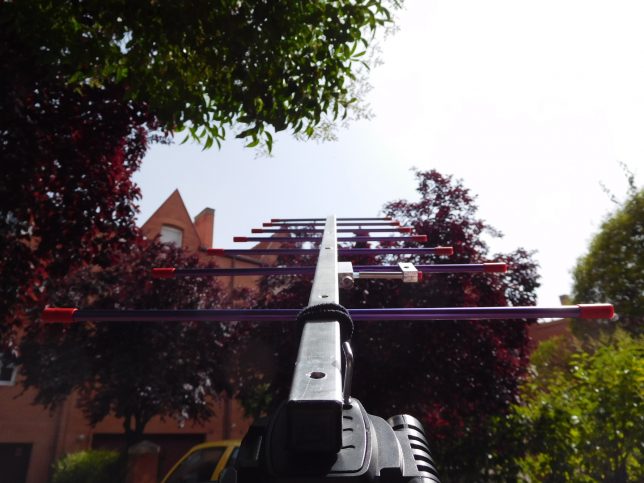
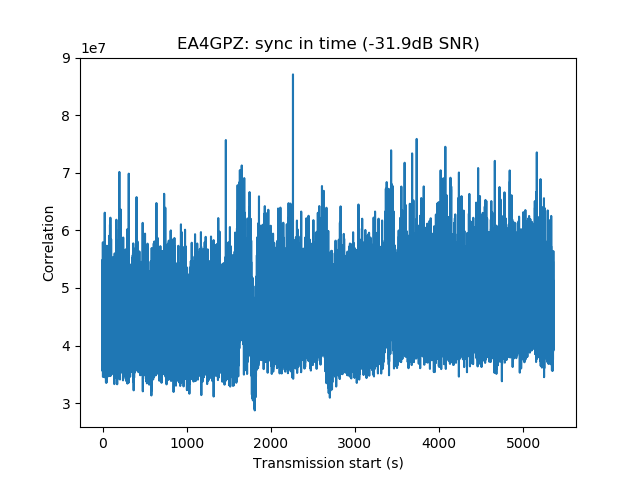
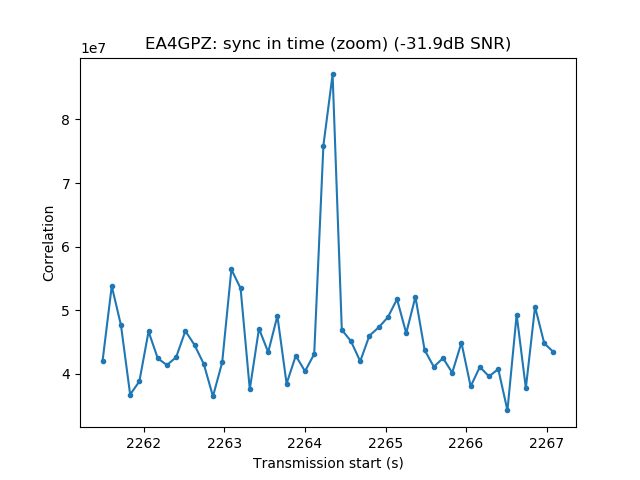
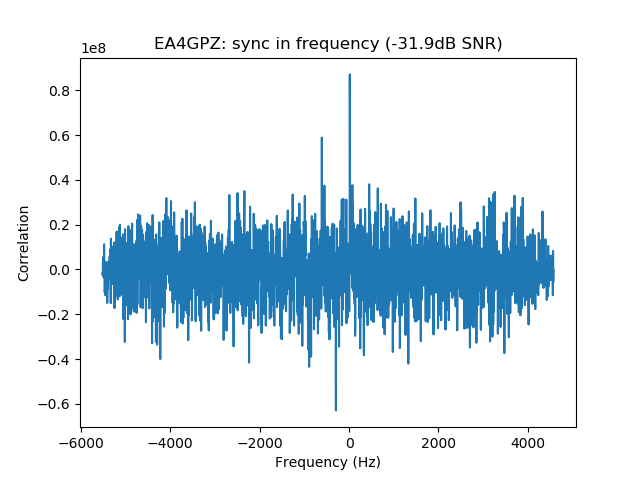

Congrats for this reception ! Do you know when next JT4g transmissions are planned ? Here f9ft 21el horiz polar yagi.
73 de Michel F6HTJ
The next UHF test is today from 12:00 to 14:00 UTC. I assume that this will include some form of JT4G, but I am not certain. It is best to watch BG2BHC’s Twitter for last minute information and also to keep an eye for people with larger stations posting reports on Twitter in real-time.
NEXT DSLWP-B UHF test !!
DSLWP-B UHF test,
GMSK on 435.4, JT4G + GMSK on 436.4 this time
30 Jun 00:00 to 30 Jun 02:00,
30 Jun 05:00 to 30 Jun 07:00,
30 Jun 16:00 to 30 Jun 18:00,
1 Jul 07:00 to 1 Jul 09:00,
all time in UTC
https://twitter.com/bg2bhc